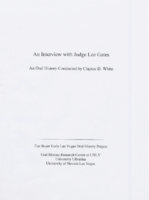Search the Special Collections and Archives Portal
Search Results

Transcript of interview with Eugene Buford by Claytee D. White, September 12, 2006
Date
Archival Collection
Description
Interview with Eugene Buford conducted by Claytee D. White on September 12, 2006. Buford came to Las Vegas as a child from Birmingham, Alabama. He held a variety of jobs, including washing dishes at the Last Frontier and delivering ice to casinos like the Flamingo and the Stardust, and ultimately retired after thirty-six years with the Post Office. Buford's great grandmother, Mary Nettles, was instrumental in the formation and growth of the NAACP chapter in Las Vegas, and he recalls meetings in her house and his own role as president of the Junior League NAACP. Buford shares memories of historical locations and events such as Helldorado, Block 16, and Carver Park, and several important figures in Las Vegas history, including James B. McMillan, Charles West, Jimmy Gay, Benny Binion, and the mafia.
Text

Transcript of interview with Judge Lee Gates by Claytee D. White, December 5, 1996
Date
Archival Collection
Description
Interview with Judge Lee Gates conducted by Claytee D. White on December 5, 1996. Born in Louisiana, Gates moved to Las Vegas around 1960. Following high school, he attended UNLV, where he was a member of the Black Student Association and studied under professor Roosevelt Fitzgerald, who raised his awareness of black history. Gates participated in the civil rights movement and worked as a lawyer before becoming a judge. He discusses Jackson Street, Dr. Charles West, attorney Charles Kellar, and his own involvement with Ruby Duncan's group.
Text

Transcript of interview with Samuel E. Wright by Claytee D. White, October 8, 2010
Date
Archival Collection
Description
Interview with Samuel E. Wright conducted by Claytee D. White on October 8, 2010. Wright candidly discusses growing up during the 1960s racial riots and notes the influence of black activist Stokely Carmichael during that era. He attended Howard University and began a career in public transportation that eventually brought him to Los Angeles and then to Las Vegas with a personal invitation from Mayor Bill Briare. Arriving in Vegas in 1979, Wright worked for the Regional Transportation Commission for twenty-six years, improving systems for a rapidly expanding city. Wright's career ignited his interest in preserving local history and neighborhoods, leading him to start a non-profit organization called PlaceMakers with Las Vegas architect Bob Fielden.
Text
Shelly Roberts tours Stardust Gambling Museum: video
Date
Archival Collection
Description
Moving Image

Transcript of interview with Pauleen Foutz by Don Scott Kaye, February 25, 1980
Date
Archival Collection
Description
Text
Doris Hancock Photograph Collection
Identifier
Abstract
The Doris Hancock Photograph Collection (1882-1987) contains photographs of Las Vegas, Nevada educator Doris Hancock and her family. The collection includes images of Southern Nevada and surrounding areas, particularly the mining town of Rhyolite, Nevada, the Colorado River, the Hoover (Boulder) Dam, Red Rock Canyon, early Las Vegas, and Death Valley, California.
Archival Collection
Master: National Finals "BBQ cook-Off and Party," hosted by Stardust: video, 1987 May 08 to 1987 May 09
Level of Description
Scope and Contents
Local news segments on the Stardust's "old-time gambling museum" which houses a $3 million dollar collection put together by Boyd Gaming and part of a larger renovation. First segment interviews Ralph Purnell, Stardust General Manager, who explains why the museum was put together as a new attraction, comparing it to Imperial Palace's car collection. In the second segment, Sam Boyd is seen leading the first tour through the museum. A brief history is provided on gaming and gambling, while stills of early Las Vegas are shown. Purnell speaks again on why the museum was created. The third segment the interior of the museum and artifacts around the museum. Interview with E. J. Cummins talks about hiding these artifacts while it was illegal, and the reporter speaks with historians about various early gaming machines. Original media VHS, color, aspect ratio 4 x 3, frame size 720 x 486.
Archival Collection
Collection Name: Stardust Resort and Casino Records
Box/Folder: Digital File 00, Box 049
Archival Component
Bess Hanson oral history interview
Identifier
Abstract
Oral history interview with Bess Hanson conducted by Debra Puepke on February 25, 1971 for the Ralph Roske Oral History Project. In her interview Hanson discusses growing up in Las Vegas, Nevada and raising a family there.
Archival Collection
Willis Clark Evans oral history interview
Identifier
Abstract
Oral history interview with Willis Clark Evans conducted by Bernard Timberg on February 5, 1974 for the Ralph Roske Oral History Project on Early Las Vegas. In this interview, Evans discusses his father, Native American archaeologist Willis Lyman Evans, his mother, Jessie Dave Evans, his uncle, Henry "Hank" Dave as he recounts his upbringing and family history. He shares memories of family trips around the United States, hunting trips, learning traditional crafts from his father, finding artifacts, and visiting Richard "Chick" Perkins at the Lost City Museum. He also recounts stories about his mother and her Shoshone family, including stories about his uncle's experiences as a ranch worker in Northern Nevada.
Archival Collection
Helen J. Stewart Photographs
Identifier
Abstract
The Helen J. Stewart Photographs depict the Stewart Family from approximately 1860 to 1950. The photographs primarily depict Helen J. Stewart and her children as well as the Stewart Ranch (also know as the Las Vegas Ranch) in Southern Nevada. The photographs include the early Las Vegas, Nevada town site, landscapes of Southern Nevada and the American Southwest, mines and mining camps, railroads and railroad workers, the Las Vegas Fort (also known as the Old Mormon Fort), hotels and early businesses in Las Vegas, Native Americans and Native American artifacts, and postcards.
Archival Collection
